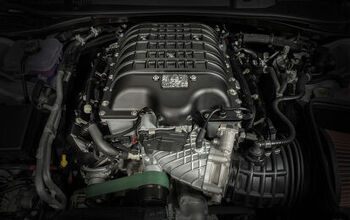Ford Foretells Fabulous Fourtune, Disses Displacement

The V6 wars may show no signs of stopping. However, Ford is quietly making contingency plans for a future conflict: The war of the four-bangers. Start hoarding your big bore brutes and head for the hills. Ford may want to take them away.
Ford will use the upcoming SAE World Congress, to be held from April 13-15 in Detroit, to showcase its engine-building prowess. Ford will demonstrate to the world’s most eminent confab of piston-heads that there is a replacement for displacement.
On display (at least in PowerPoint form) will be three new four-cylinder mills. A 1.6-liter Twin Independent Variable Camshaft Timing (Ti-VCT) Sigma I-4, a 2.0-liter direct-injection Ti-VCT Duratec® I-4 and a 2.0-liter Ti-VCT EcoBoost™ I-4.
That alone wouldn’t be worth the keystrokes for that post, wouldn’t Ford’s press release stress the point that small is beautiful, that V8 brutes are going the way of the dodo, and that the destiny of the V6 may be doubtful.
The four-bangers are Ford’s response “to shifts in consumer buying patterns with the introduction of more fuel-efficient small engines.”
In1969 “nearly 90 percent of vehicles sold in America were powered by V-8s,” says Ford. Last year, the share of the eights was down to 4.9 percent, “an all-time low,” while I-4s dominated with nearly 62 percent, according to Ford’s numbers. The way they are announcing this, they make us believe that that number will rise to European and Japanese proportions. It used to be an overseas thing to get more and more power out of smaller and smaller engines. No more: Ford is stepping up to the (most likely CAFE-induced) plate full of mini-mills.
The 2011 Ford Fiesta, powered by a 1.6-liter Ti-VCT I-4, is projected to deliver 40 mpg on the highway. The turbocharged 2.0-liter I-4 promises fuel economy “at least 10 percent better than a comparable V-6, while delivering class-leading power and torque for an I-4,” fawns Ford over the four.
And where are the batteries? Not included? A “more efficient battery-electric vehicle culture” receives only passing mention in the announcement. Ford forecasts that by 2020, plug-ins, hybrids, and plug-in hybrids might garner “up to 25 percent of total vehicle sales in the U.S., Europe and Japan.”
Paul Mascarenas, Ford vice president of Engineering Global Product Development, who happens to be chairman of the 2010 SAE World Congress, sounds like someone working at Volkswagen when he says: “As important as alternative energy sources are, in the foreseeable future most passenger cars and light trucks will continue to use petroleum-based fuels. Our challenge in the engineering community is to make them vastly more efficient.”
Ford makes it clear that the ICE is here to stay for the foreseeable future. And it looks more and more like a fourseeable future.

Bertel Schmitt comes back to journalism after taking a 35 year break in advertising and marketing. He ran and owned advertising agencies in Duesseldorf, Germany, and New York City. Volkswagen A.G. was Bertel's most important corporate account. Schmitt's advertising and marketing career touched many corners of the industry with a special focus on automotive products and services. Since 2004, he lives in Japan and China with his wife <a href="http://www.tomokoandbertel.com"> Tomoko </a>. Bertel Schmitt is a founding board member of the <a href="http://www.offshoresuperseries.com"> Offshore Super Series </a>, an American offshore powerboat racing organization. He is co-owner of the racing team Typhoon.
More by Bertel Schmitt
Latest Car Reviews
Read moreLatest Product Reviews
Read moreRecent Comments
- Lorenzo I just noticed the 1954 Ford Customline V8 has the same exterior dimensions, but better legroom, shoulder room, hip room, a V8 engine, and a trunk lid. It sold, with Fordomatic, for $21,500, inflation adjusted.
- Lorenzo They won't be sold just in Beverly Hills - there's a Nieman-Marcus in nearly every big city. When they're finally junked, the transfer case will be first to be salvaged, since it'll be unused.
- Ltcmgm78 Just what we need to do: add more EVs that require a charging station! We own a Volt. We charge at home. We bought the Volt off-lease. We're retired and can do all our daily errands without burning any gasoline. For us this works, but we no longer have a work commute.
- Michael S6 Given the choice between the Hornet R/T and the Alfa, I'd pick an Uber.
- Michael S6 Nissan seems to be doing well at the low end of the market with their small cars and cuv. Competitiveness evaporates as you move up to larger size cars and suvs.


































Comments
Join the conversation
The actual numbers come from WardsAuto, and are summarized here: http://wardsauto.com/ar/engines_lose_ground_100315/ As you inferred, the 4.9% number refers only to cars, not to total vehicles. Among light trucks, V8s have a 40% share--a number that is clearly diluted by the RAV4, CR-V, Escape and the like.
I still recall reading all about the Model T's engine. Innovative design, used a bolt on head which was an innovation, and got 25MPG. It had extensions that allowed the engine to run farm machinery, and used a type of steel that Henry Ford noticed being used in French racing cars; he built a plant to produce this steel at his Detroit plant, and used it in engines, the suspension, and other key places to give the Model T incredible durability. And here we are all these years, decades later, still using internal combustion engines, as if there is nothing else out there. I accept that like the wheel, the internal combustion engine is just simply the best answer, but wow, think of how long this design has been around. "Forever."